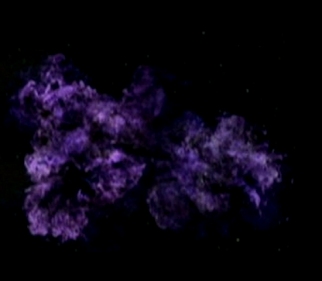
In Star Trek, dark matter nebulae are accumulations of
dark matter, that are difficult to detect on sensors unless illuminated
by metreon particles. (ENT: "First Flight"). When he was a guest aboard
the Vulcan starship Yarahla, Captain Jonathan Archer assisted on their
study of a dark matter nebula. (ENT: "Breaking the Ice"). A second dark
matter nebula was observed by Captain Archer and Subcommander T'Pol in
March of 2153. It was named the Robinson Nebula in honor of the late
A.G. Robinson. (ENT: "First Flight")
In 2367, the USS Enterprise-D explored the previously
uncharted Mar Oscura Nebula. The nebula was littered with spatial
deformations, making travel hazardous. (TNG: "In Theory")
In 2371, the USS Voyager encountered trianic energy
beings known as the Komar in a dark matter nebula in the Delta
Quadrant. (VOY: "Cathexis"). Neelix said that he once lost a warp
nacelle on a ship he was piloting through a dark matter nebula. (VOY:
"Threshold")
An uncharted dark matter nebula was located in
Cardassian space, near a Dominion ketracel-white storage facility
destroyed by Captain Benjamin Sisko and his crew in 2374. Sisko ordered
his damaged ship into the nebula to escape several pursuing Jem'Hadar
fighters, whereupon they crashed on an uncharted planet. (DS9: "Rocks
and Shoals")
In astrophysics, some nebula may indeed contain
concentrations of dark matter. The famous "Snake" or "S" dark nebula in
Ophiuchus, for example, is a concentration of obscuring dust and dark
matter in space that is opaque and doesn't let the stars behind show
through it. Dark matter is hypothetical matter that does not interact
with the electromagnetic force, but whose presence can be inferred from
gravitational effects on visible matter. According to present
observations of structures larger than galaxies, dark matter and dark
energy account for the vast majority of the mass in the observable
universe. The observed phenomena which imply the presence of dark
matter include the rotational speeds of galaxies, orbital velocities of
galaxies in clusters, gravitational lensing of background objects by
galaxy clusters such as the Bullet cluster, and the temperature
distribution of hot gas in galaxies and clusters of galaxies. Dark
matter also plays a central role in structure formation and galaxy
evolution.
All these lines of evidence suggest that galaxies,
clusters of galaxies, and the universe as a whole contain far more
matter than that which interacts with electromagnetic radiation: the
remainder is called the "dark matter component." The dark matter
component has much more mass than the "visible" component of the
universe. Only about 4% of the total energy density in the universe (as
inferred from gravitational effects) can be seen directly. About 22% is
thought to be composed of dark matter. The remaining 74% is thought to
consist of dark energy, an even stranger component, distributed
diffusely in space. Determining the nature of this missing mass is one
of the most important problems in modern cosmology and particle
physics.
The term 'dark matter nebula', however, should not be
confused with the real astronomical term 'dark nebula'. This a type of
interstellar cloud that is so dense that it obscures the light from the
background emission or reflection nebula (e.g., the Horsehead Nebula)
or that it blocks out background stars (e.g., the Coalsack Nebula). The
extinction of the light is caused by interstellar dust grains located
in the coldest, densest parts of larger molecular clouds. Clusters and
large complexes of dark nebulae are associated with Giant Molecular
Clouds. Isolated small dark nebulae are called Bok globules. The form
of such dark clouds is very irregular: they have no clearly defined
outer boundaries and sometimes take on convoluted serpentine shapes.
The largest dark nebulae are visible to the naked eye, appearing as
dark patches against the brighter background of the Milky Way. In the
inner regions of dark nebulae important events take place, such as the
formation of stars and masers.
|
